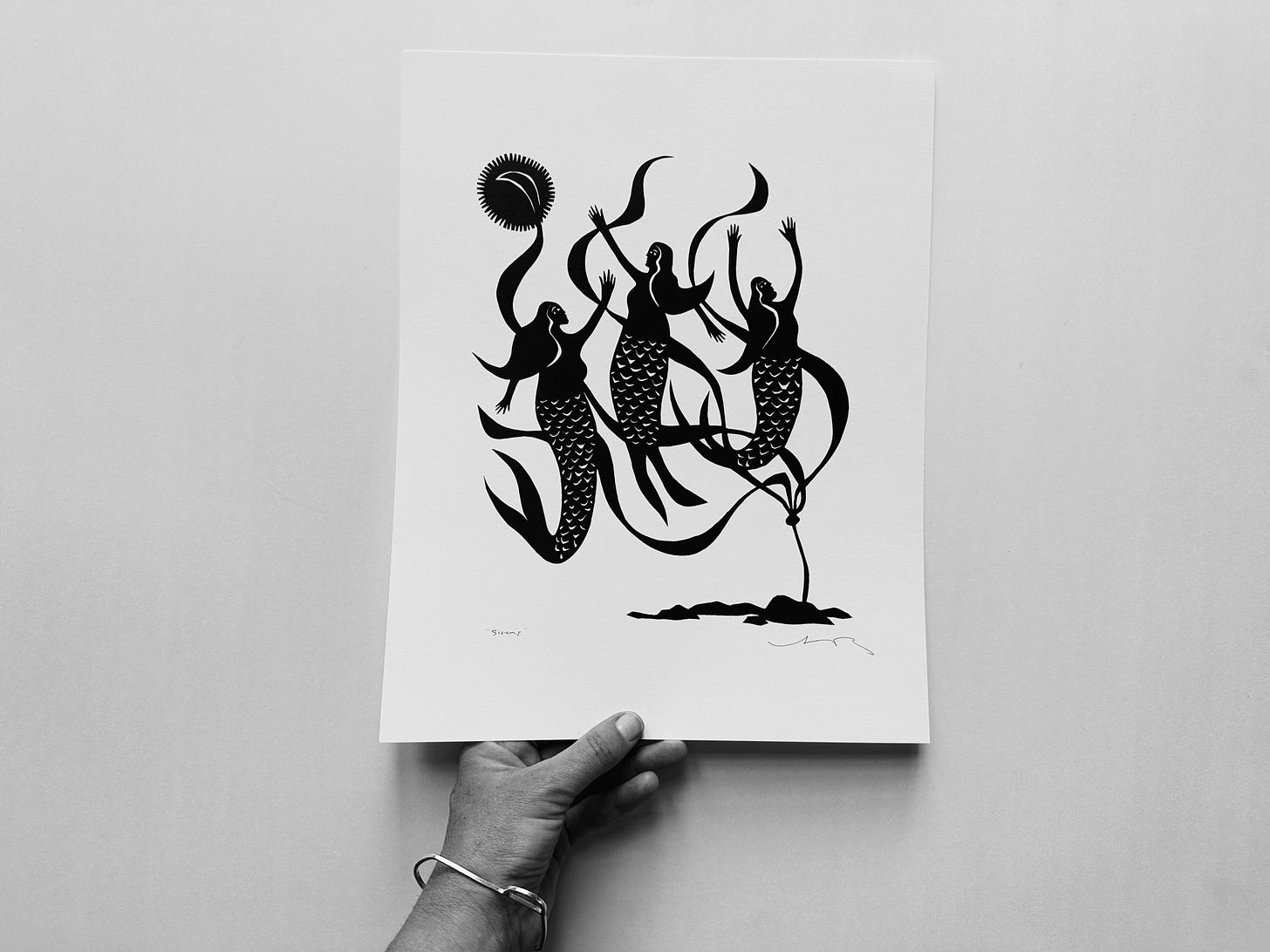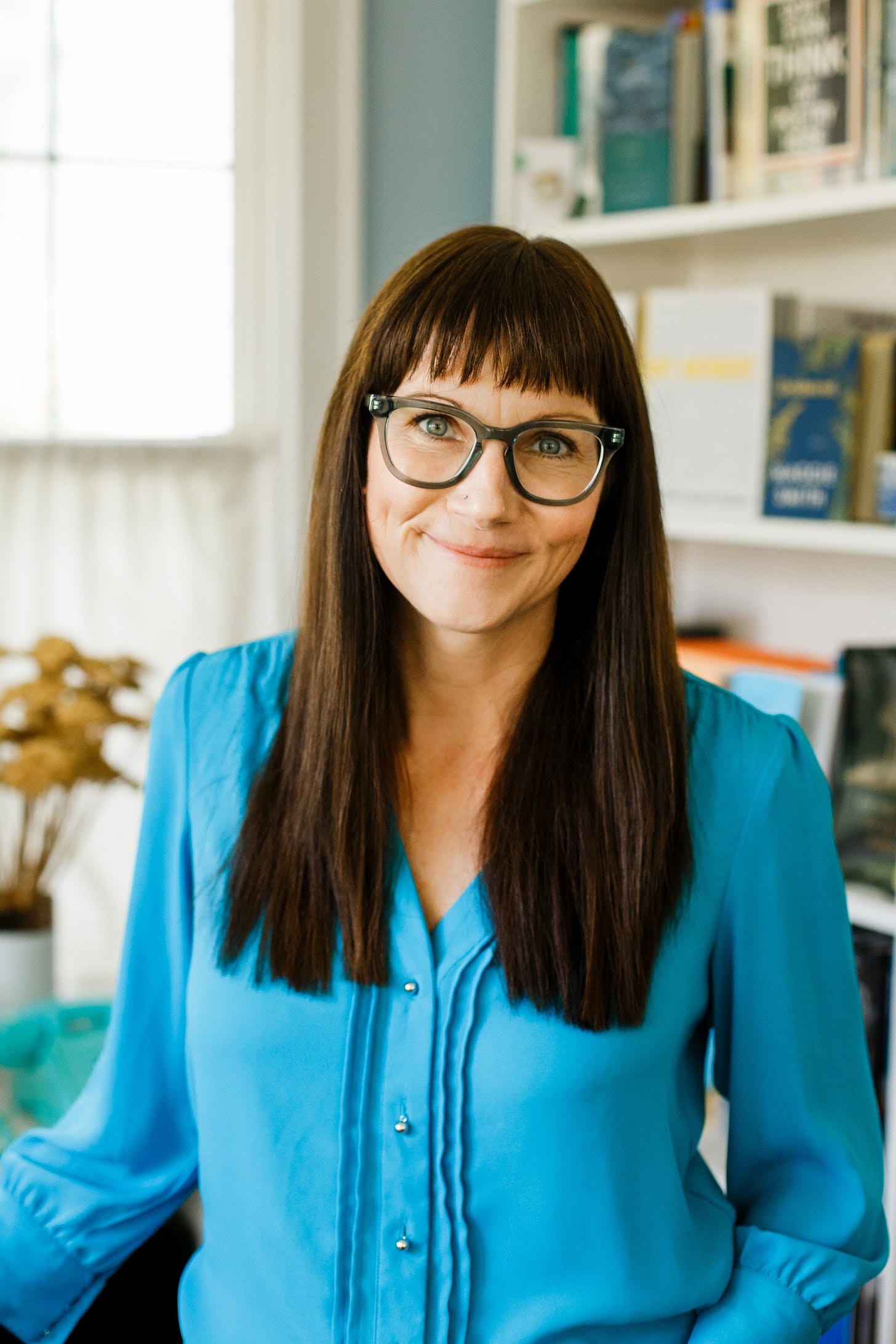"To be creative is to push back, again and again, against despair, complacency, and cruelty."
A conversation with Maggie Smith.
New cards and prints in the shop including these sirens // Tickets for the fall session of DIVE, the Creative Fuel Collective seasonal writing group with
are now available — sign up for before August 1st for earlybird pricing.Hello friends,
I’ve been deep in “rough book draft land” lately. Rough because it’s actually a rough draft, but also rough because, well… that too. If this was an island (because I love to map every kind of emotion and state of being as an imaginary island) then it would be surrounded by very unexpected currents and tides. This is a notorious place for losing boat paddles and missing ferries. In fact, if you look around the boat, I think someone forgot to bring the life jackets too.
This is the middle part. The bit where you question everything and definitely need someone who is standing on shore to help encourage you that yes, you should still keep trying to move the boat forward.
I’m bringing you a Q&A with
today, which I’ve been very excited about sharing. If you already follow Smith’s newsletter, then you know that she sends out regular pep talks. Because there are all kinds of pep talks in her new book, I asked her was when she was most in need of one. Her answer? The middle part.In re-reading her response as I prepped the newsletter to send today, seeing that answer that made me give a little sigh of relief. I felt a little less alone in my process.
You may know Smith from her popular poem “Good Bones,” her memoir You Could Make This Place Beautiful, or maybe a friend has passed along her words at some point and they have landed when you need them. Smith strikes a chord, particularly in our current moment. When we struggle to find the words, she is there to help offer us the language we need.
Smith is also responsible for one of my favorite expressions: “beauty emergency.” The term is for any of those moments where you have to “stop and pay attention to right at that moment, because it’s fleeting.” Sunsets, the way light casts a shadow on a wall, the shape of a cloud. Beauty emergencies will always stop you in your tracks. They ask you to pay attention.
My latest beauty emergency: sitting out late with friends the other night and realizing that the full moon was rising. More golden than usual, the glow emanated from behind the dark tree silhouettes. We all paused, got quiet, stared at it for a bit. We continued talking, but I kept turning my head every few minutes to see how far up in the sky it had gotten. It seemed to be inching upwards so quickly that maybe if I looked at it hard enough I could almost see it move in real time.
You could say that this kind of attention to the world is the work of artist and writers, that some of us are more attuned to these kind of occurrences. But Smith would argue that this way of seeing is for all of us. I agree.
Early on in Dear Writer: Pep Talks & Practical Advice for the Creative Life, Smith shares a story of going into the second-grade classroom at her children’s elementary school to talk about poetry. She gets a look at the language arts textbook the class was using. In it, poets are described as having “poet’s eyes,” a special way to view the world. Nice visual, right?
Smith immediately points out to the class that there is no such thing. “Every child is born with poet’s eyes. We all have them, we just have to keep using them,” Smith writes. She continues:
“As we age, we can become distracted and desensitized. We have to pay better attention, but more than that, we have to find ways to make the familiar strange again, to see the extraordinary tucked inside the ordinary, and to marvel at our surroundings rather than take then for granted. ‘Poet’s eyes’ are for all of us, the way the tools of poetry are for all of us.”
There is craft-specific wisdom in Dear Writer that’s particular to anyone playing and experimenting with the written word, but her insight applies to any creative medium. Reading the book I was reminded at how much richer and robust art makes our lives, both in its creation and enjoying what someone else has brought into the world.
For Smith, creativity is a lifelong acquaintance, a collaborator, an instigator. This book is a love letter to not just the creative process, but to opening ourselves, to expanding, to unlearning all the things that keep us from seeing the world with a sense of curiosity. As she writes, “art is about letting yourself be changed. If you aren’t growing, what’s the point?”
Am I fangirling a little bit to have her here in the Creative Fuel newsletter? Yes, absolutely.
Pour a cup of coffee and let her wisdom settle in. And then maybe, write some poetry.
-Anna
Anna Brones: Creativity is an uncertain process. How has working with that kind of uncertainty informed how you deal with uncertainty in your own life?
Maggie Smith: We all live with uncertainty our whole lives, even as children. (I’m tempted to say especially as children, because the uncertainty of childhood comes without the decision-making power we have as adults.) I suspect that discovering my love of poetry as an adolescent helped shape me not only as a writer but also as a thinker. Writing changed—and continues to change—the way I metabolize my experience; it’s taught me how to live with uncertainty, with ambiguity, with what Keats called “negative capability.”
I am curious if there is something that teaching has taught you about creativity and writing that writing alone couldn’t?
One of the gifts of teaching is seeing how different writers work. You only know your own process, and it might be tempting to project that onto others and think that we’re all approaching our work the same way. Working with students over the years has been a great reminder that the process isn’t one size fits all.
Creativity isn’t just about making art. Making your life is the ultimate creative act.
Maggie Smith, Dear Writer: Pep Talks & Practical Advice for the Creative Life
What does your own process look like?
I tend to write longhand first, jotting down initial notes and even drafting on a legal pad or in a notebook, though I am relying more and more on the Notes app in my iPhone these days. I like my legal pads yellow and my notebooks hardcover, but I’m not a brand loyalist. My pen of choice is the uni-ball Vision Elite Rollerball in black. I buy them by the box.
Once I start to find the shape of what I’m writing, or once the page starts to get too messy or unwieldy, I’ll open a Word doc on my laptop. Then I’m off and running. I number my drafts as I make changes, and I don’t delete them. Ever.
When do you most need a creative pep talk?
Probably in the middle of a project. In the beginning, I’m excited to be off and running. Toward the end, I’m energized by sensing the finish line up ahead. But the middle, when you’re distanced from the spark but can’t quite see how it’s all going to come together yet, is the perfect time for a creative talk.
Creativity is so very much a part of who we are as humans. As you quote Ai Weiwei in the book, “creativity is part of human nature. It can only be untaught.” What are some cultural conceptions about creativity or ways of thinking about creativity that hold many of us back from embracing our true creative nature?
Part of what I wanted to do with Dear Writer was dispel some of the myths about creativity, and one of those myths is that only some people are creative—as if you’re either born an artist or a writer, or you’re not. I hear people say things like “Oh, I’m not creative” or “I don’t have that in me,” and I want to tell them they’re wrong. They are, and they do. Creativity is our birthright as human beings. We are all creative, and we all have the capacity to lean into that part of ourselves even more.
You write about cross-pollination in the book, the importance of connection with other writers and works of art. Along those lines, do you have any other creative mediums/outlets that you do, and if so, how do those inform your writing?
I don’t! I love music but don’t play an instrument. I love films and plays but don’t act. I love visual art but don’t paint or sculpt. Writing’s it for me.
The concept of a “creative self” pops us a lot in this book. It’s us, but it can also be a little outside of us. It can be a collaborator, a brainstorming partner, something to challenge us, something to inform our work. I love how you frame this in the opening to the Connection section, capturing that feeling of what it’s like to be in “cahoots with something that feels bigger than you and yet is you.” I am wondering how you think about your own creative self? What does it need in addition to what you need as an individual? How do you take care of it?
It is strange to think about regarding my creative self as somehow separate from my “self self.” I don’t feel the separation, to be honest. As an individual and as a writer, I need a balance between solitude and stimulation. Getting the balance right is sometimes tricky, and it’s always part of the job.
What was your most recent beauty emergency?
Enormous cumulus clouds above the local elementary school on my walk today. “Majestic,” my daughter said, and she was right about that.
What does it mean to be an artist?
To me, being an artist means making it your business to be open, to tell the truth, and to prioritize curiosity and risk over comfort.
What does it mean to be creative?
I keep coming back to this Maxine Hong Kingston quote: “In a time of destruction, create something.” To be creative is to push back, again and again, against despair, complacency, and cruelty.











‘Beauty Emergency’ is a favorite of mine as well. My almost 4-year-old is great at reminding me to stop and look at them.
I might have lost sight of the bones. It seems like the chirping realtor of the moment is the one who has hidden the bones, but I think creative eyes can find them and until then my colorful, messy, backyard provides nothing but beauty emergencies!
Love this entire post thank you .